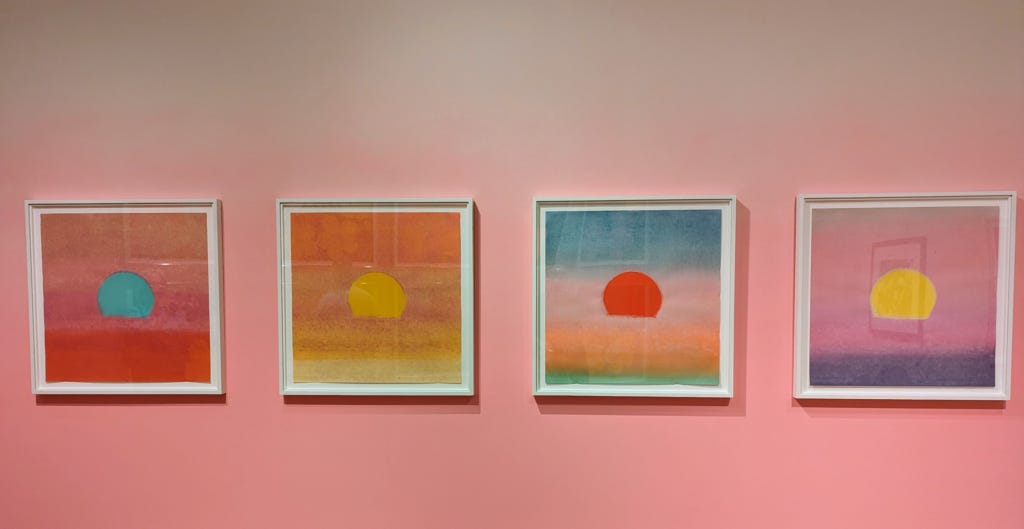SLDXO Convo: Warhol at the Cleave Carney
[DXO]
Yesterday we saw the new Warhol show at the Cleave Carney Museum of Art at the College of DuPage in Glen Ellyn, Illinois, Portfolios: A Life in Pop: Work from the Bank of America Collection.
What did you think?
[SL]
I thought the show was great. I love the fact that so much of it was totally open to the public. There's a fun Studio 54 room where they show films and play music from Andy’s birthday party there, and they actually created costumes that matched what famous people were wearing, like Elton John, Diana Ross and Bianca Jagger. I thought that was a very fun way to create engagement.
They also had a children's section (silkscreens of some of his 25 cats-- all named Sam) where people could create their own art. I think the creators of the experience did a really wonderful job and provided lots of opportunities for people to see things for free and learn about Warhol, even if they don't end up seeing the Bank of America Collection, which requires an admission fee.
[DXO]
Absolutely. I thought they just did a great job on interpreting Warhol’s backstory, too. It’s hard to say something new about Warhol, but they put it together in a really accessible way. Obviously I'm from Pittsburgh, and you know people from Pittsburgh can get Pittsburgh-y, especially when it comes to Warhol, with the museum and the foundation based there. But the way they covered his studies at the Carnegie Institute, his sickliness, and his father working on the railroad was excellent. Throughout the show they reference his Catholicism and how important it was to him. The recent show at the Brooklyn Museum called Andy Warhol: Revelation dove deeply into this. Being a Pittsburgh Catholic, it’s like “Go go Warhol”.
The wall tags were great because they often noted the image that Warhol appropriated. It was good to see that— it’s interesting to know that the Hibiscus series came from an image in the June 1964 issue of Modern Photography, for instance.
What stood out for you in the show?
[SL]
I think the Bank of America Collection—and it was fascinating to me that they owned so many different pieces— had lots of surprises. For example, there were landscapes of Mount Vesuvius. I had not really seen landscapes from Warhol among his silkscreen series.
Another thing we had never seen before was the series of sunsets he did for the Marquette Hotel in Minneapolis, designed by Philip Johnson. Warhol created 472 unique screen prints—one for each room.
[DXO]
Yes, those were great. We talked about the staging of the show— exquisite. Putting the hyacinth series on a silver wall, the Campbell soup cans on red and white, the Keith Haring collaborations on Haring wallpaper. The red cow wall linking galleries— well done.
[SL]
I liked how they reversed the red and white wall compared to the Cambell’s labels, and I especially liked that the red on the soup can wall was not the color of the red on the can— it was the color of actual tomato soup.
[DXO]
We also saw a lecture by Blake Gopnik, who wrote the “Warhol” biography that was published right before the pandemic. He drove into detail on a few different pieces. The thrust of his talk was that deep investigation of Warhol’s work yields a real thoughtfulness, seriousness, and mastery of form. He also spoke of Warhol’s art history education and Gopnik makes the case that Warhol explicitly did his work in the context of art history.
He talked about the Myths series of 10 works— the Wicked Witch of the West, Uncle Sam, Santa Claus— and he put himself in there as a myth in the lower right of the series, as if it were a signature. Gopnik talked about the antecedents to the image of the artist in portraits. He also spoke of the difference between the original 1962 soup cans and the series Warhol completed in 1969, with the former having more "handmade" looking components.
He also railed against the recent Supreme Court decision, saying that it will have a chilling effect on the creation of new art. This is the common bleat of the “Warhol exceptionalists”-- they think that when he’s involved, some sort of magic spell happens that doesn’t apply to other artists, living or dead. In fact, the Court made a very very narrow ruling focused on the fact that both the plaintiff and the defendant were in the same market— selling illustrations for magazines.
[SL]
Gopnik further discussed Warhol in the art historical context regarding those 472 sunset silk screens. He compared the color choices, the lighting effects and the series itself to Monet's wheat stack series. (Apparently, all of these years art historians have erroneously referred to them as haystacks, when the are indeed wheat stacks.) You can definitely see an Impressionistic influence in the sunsets. And since they were created as art for decor in hotel rooms, I don't think it's surprising that Warhol turned to the prettiness of Impressionism.
Gopnik also discussed Warhol's use of himself as material for his art: the intersection of commerce and art creation. The idea of a conceptual artist at that junction is what we see current artists like Jeff Koons exploit/deploy.
[DXO]
It was great to be there for opening day. The exhibit runs through September 10, and there are all sorts of things going on in the community related to the show— they do a great job at that— pulling in the whole community. Lectures, concerts, scavenger hunts, and so on. There’s public art showing Warhol-esque illustrations of famous people from DuPage County, art classes, dining & beverage / hotel partners. So it's a really great way to engage the entire community through the whole summer.
Lots more information at http://warhol2023.org/.

















